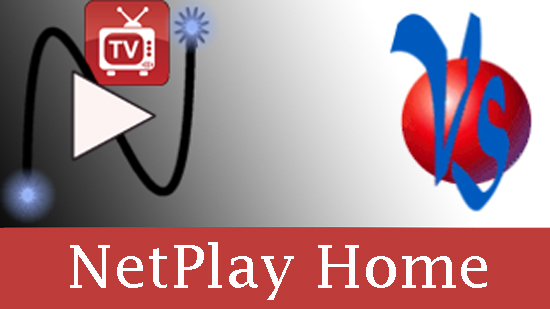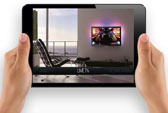Order Directly Online!
NetPlay Home
NetPlay Pro
Digital Signage
Your Cart
| 0 Product(s) in cart |
| Discounts $0.00 |
| Total $0.00 |
| » Checkout |
NetPlay Home 4K for Residential Installations
This guide is intended to describe installation options you would use in residential installations. If you are a professional installer, remember to include the cost of installation and support when quoting your project.
Click on the picture below to play our NetPlay Home promo video
Unique features of NetPlay Home:
- Video Tiling and PIP
- Digital Signage with SplashTiles
- IP Camera Integration
- Voice control with Alexa
See below for more details on planning your NetPlay Home system:
NetPlay Home HDMI distribution: (Slide illustration)
A NetPlay distribution system is a "virtual matrix" switch. You can add as many sources and displays as needed. Because NetPlay is a "decentralized" system, your sources do not need to be grouped together in a single location.
Live HDMI Sources: NetPlay Home uses network HDMI encoders to bring all your "live" HDMI sources into the matrix system. This will be any source device with a HDMI output that does not fall into the directly integrated categories below. Use NetPlay Ready encoders for each of your HDMI sources.
Camera Sources: IP cameras and most NVRs can be directly integrated in the matrix system without needing VTX encoders for these.
File Sources: File sources such as movie and music libraries can also be directly integrated in the matrix system. Both video and image sources or playlists can be used.
Web Sources: Web sources such as web pages or data feeds can also be directly integrated in the matrix system. Full support for HTML5, WebGL, and embedded iframes.
Streaming Services Sources: NetFlix, Amazon Video, Vudu, Hulu, and nearly all streaming services are directly supported as Apps running on your NetPlay TV devices. Any service which has an Android app is supported.
Gaming Sources: NetPlay supports the latest game streaming technologies for whole home gaming. Please see our NetPlay Home Gaming page for more details. If you are using older gaming consoles (Xbox, Playstation, Wii) with an HDMI output, we do not recommend encoding the HDMI output for distribution. Modern games requires zero latency, so the small latency HDMI distribution introduces would degrade the gaming experience. These older gaming consoles should be physically located with the individual televisions.
HDHomeRun Sources: Low cost HDHomeRun devices can be used to integrate over the air (OTA) broadcast and cable tv (cable card) content directly into the matrix system.
GoogleCast/ChromeCast Sources: All supported NetPlay TV devices include support for GoogleCast/ChromeCast. Either audio or Video can be directly streamed to any display from Android devices.
Android TV Displays: Sony and Sharp TVs running Android TV can integrate directly with NetPlay Home without requiring any additional equipment. NetPlayTV will run natively on these TVs.
Standard TV Displays: Standard TVs will use an external Android or Android TV device (running NetPlay TV app) to provide audio, video, and control to the TV via HDMI and optionally IR. Many popular devices are compatible with NetPlay TV, including Amazon Fire Stick 4K, nVidia Shield, and more.
Mobile players: Mobile devices (such as tablets and smart phones) can play back NetPlay video sources directly. NetPlay Home NetPlay Manager includes the required license for control and video preview on all your mobile devices. Full screen playback on mobile devices requires a supplimental license purchase.
NetPlay Home audio distribution:
Your NetPlay Home display devices will receive synchronized audio via the same network stream as the video. This audio is always present on the HDMI output, but some devices may also have optical or analog outputs. Simply route the audio to your TV speakers or AVR just like any other source. You can also use extra NetPlayTV decoders to provide synchronized audio at any location.
If you are using a fully "centralized" audio solution with in-wall/ceiling speakers that are hard wired back to a central equipment rack, please use our Audio Delay devices to provide lip sync correction for your audio matrix switch.
NetPlay Home is also compatible with several Home audio streaming systems. Please see our NetPlay Home Music page for details.
NetPlay control distribution: (Slide illustration)
For full details on system control, please see NetPlay system control options.
NetPlay Home integrates Ethernet, IR, RS232, and CEC control for all your connected source and display devices. This control is provided either via NetPlay Mobile app on your Android Mobile devices or directly at each TV using the NetPlayTV gui itself and the included remote controls. In fact, both control methods can be used at the same time by different users.
NetPlay TV devices with USB ports can use IRUSB to provide direct IR control of the attached TV, speakers, or AVR. IRUSB also provides full centralized IP control (menu navigation, app launching, playback control) of your NetPlay decoder devices.
NetPlay Manager can use IRUSB to provide direct IR control of your HDMI source devices.
NetPlay Home can also be integrated in third party control systems using our existing drivers.
NetPlay Home network and wiring requirements: (Slide illustration) (Retrofit Slide illustration)
NetPlay Home uses your standard home network for audio and video distribution.
Wiring can be via any combination of ethernet technology. Cat5/5e/6 is the easiest and should be used whenever possible. For retrofit application, you can use existing RG59/RG6 coax via MOCA ethernet over coax. We recommend the ActionTec ECB6200S02 adapters. Wireless ethernet can be used as a last resort, since interference can degrade picture quality. NetPlay video streams are ~20Mbps each. NetPlay Mobile devices will use wireless ethernet, but at lower data rates.
The network switch or switches will need 1 port for each NetPlayTV display and 1 port for each network HDMI encoder. Switches can be cascaded as needed, but make sure the interswitch connections are 1000mbps. NetPlay can use the same network as all the other devices in your home.
The network router will need a DHCP server enabled (this is default on nearly all routers).
The network switch ports connecting to network HDMI encoder devices should be 1000mpbs capable. The ports for NetPlay TV devices should be 100mbps or higher. Most switches support both speeds.
All NetPlay devices should be on the same subnet if possible. If this is not possible, routing rules must exist between the subnets. VLANs are not required or recommended. Devices should have access to the internet for app updates or cloud streaming.







